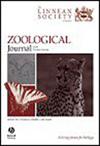Osteology and ontogeny of the Permian dicynodont Rastodon procurvidens (Synapsida, Therapsida) based on micro-CT scanning and its phylogenetic and biogeographical implications
IF 2.8
2区 生物学
Q1 ZOOLOGY
引用次数: 0
Abstract
Dicynodonts were a globally distributed group of herbivorous synapsids that first appeared during the middle Permian (Guadalupian) and survived the Permian–Triassic Mass Extinction, until their extinction in the Late Triassic. Their fossil record in South America is almost entirely concentrated in the Triassic, with only two described Permian species. One of these, Rastodon procurvidens, was found in the Rio do Rasto Formation in Rio Grande do Sul, Brazil, and represents one of the best-preserved Permian therapsids from South America. The phylogenetic position of Rastodon within dicynodonts remains debated, with competing hypotheses leading to radically different conclusions regarding the early biogeography of dicynodonts. In this study, we present a detailed description of both the cranial and postcranial skeleton of the R. procurvidens holotype using microcomputed tomography. Phylogenetic analyses under both maximum parsimony and Bayesian criteria support the placement of Rastodon within the emydopoid clade Kingoriidae. These findings provide the first evidence of Emydopoidea and Kingoriidae in South America and underscore the limited knowledge of dicynodonts during the Guadalupian, particularly outside southern Africa. Furthermore, they suggest an earlier origin of Kingoriidae and the possibility that the group originated in west rather than east Gondwana.基于微ct扫描的二叠纪双齿齿鼠(Synapsida, Therapsida)的骨学和个体发育及其系统发育和生物地理学意义
双齿兽(Dicynodonts)是一种全球分布的草食性下孔类动物,最早出现于中二叠纪(瓜达鲁普期),并在二叠纪-三叠纪大灭绝中幸存下来,直到晚三叠世灭绝。它们在南美洲的化石记录几乎全部集中在三叠纪,只有两个被描述的二叠纪物种。其中一种是Rastodon procurvidens,发现于巴西南里约热内卢Grande do的里约热内卢0 do Rasto组,是南美洲保存最完好的二叠纪兽脚类之一。关于齿齿兽在双齿目动物中的系统发育位置仍然存在争议,关于双齿目动物的早期生物地理学,各种相互竞争的假设导致了截然不同的结论。在这项研究中,我们提出了一个详细的描述,这两个颅骨和颅骨后的骨架,用微型计算机断层扫描。在最大简约性和贝叶斯标准下的系统发育分析都支持将拉斯顿放在拟乳类分支金鸟科中。这些发现提供了南美洲emydopo总科和Kingoriidae的第一个证据,并强调了瓜达卢普时期(特别是非洲南部以外)对双齿兽的有限认识。此外,它们还表明,Kingoriidae的起源更早,并且该群体可能起源于冈瓦纳西部而不是东部。
本文章由计算机程序翻译,如有差异,请以英文原文为准。
求助全文
约1分钟内获得全文
求助全文
来源期刊
CiteScore
6.50
自引率
10.70%
发文量
116
审稿时长
6-12 weeks
期刊介绍:
The Zoological Journal of the Linnean Society publishes papers on systematic and evolutionary zoology and comparative, functional and other studies where relevant to these areas. Studies of extinct as well as living animals are included. Reviews are also published; these may be invited by the Editorial Board, but uninvited reviews may also be considered. The Zoological Journal also has a wide circulation amongst zoologists and although narrowly specialized papers are not excluded, potential authors should bear that readership in mind.

 求助内容:
求助内容: 应助结果提醒方式:
应助结果提醒方式:


